In the early hours of 30th of June 1908, near the Tunguska river, a gigantic explosion ripped through the air, 1,000 times more powerful than the atomic bomb dropped on Hiroshima, Japan in 1945.
The blast was the largest impact event in Earth’s recorded history, destroying an area 2000km (770 miles squared), flattening over 80 million trees, and leaving a charred, inhospitable landscape in its wake.
‘The Tunguska Event’ as it came to be known, occurred near the Podkamennaya Tunguska River in the Yeniseysk Governorate (known today as ‘Krasnoyarsk Krai’) in Russia. The area is so remote that despite the vast devastation to the landscape (which would have levelled a large city), no human deaths were recorded (though the charred remains of deer and other animals could be found for miles). A man forty miles away at a trading post in Vanavara reported being blown from his chair, and heat so intense that felt ‘as if his shirt was on fire’.
The explosion was so massive that resulting seismic waves showed up on Barometers in England, and dense clouds formed at high altitudes, reflecting sunlight beyond the horizon. Newspapers from the days around the event in England and even Asia report blue skies at night, with people able to read the paper in the glow of the night skies.
The thing that still divides the scientific community regarding the Tunguska event is the cause of the impact; which has been variously attributed to the mid-air disruption and detonation of a superbolide (a meteor or comet, more than twice as bright as the full moon), antimatter, a nuclear explosion, a black hole, and many others. In all likelihood, a small icy comet or stony asteroid collided with Earth’s atmosphere on June 30, 1908. If it were an asteroid, it might have been about a third as big as a football field – moving at about 15 kilometers (10 miles) per second.
Though the wilder theories regarding extra-terrestrials have been rightfully dismissed, the main point of contention is the absence of an impact crater at the site. Historically, catastrophic meteors have collided with the earth, causing widespread devastation and extinction events, leaving in their wake huge impact craters; most notably, the Chicxulub crater in Mexico; the impact crater which is largely believed to be a result of the asteroid which caused the extinction of non-avian dinosaurs.
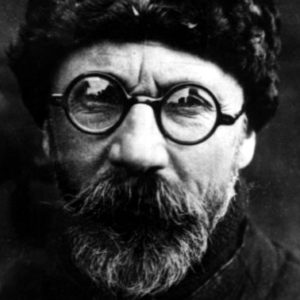
The first scientific investigation into the Tunguska explosion was conducted by Leonid Kulik –a Russian mineralogist known for his work with meteorites- who lead an expedition into Tunguska in 1927 after reading a (highly inaccurate) newspaper report from Tunguska from around 1908:
“…a huge meteorite is said to have fallen in Tomsk several sagenes from the railway line near Filimonovo junction and less than 11 versts from Kansk. Its fall was accompanied by a frightful roar and a deafening crash, which was heard more than 40 versts away. The passengers of a train approaching the junction at the time were struck by the unusual noise. The driver stopped the train and the passengers poured out to examine the fallen object, but they were unable to study the meteorite closely because it was red hot…”
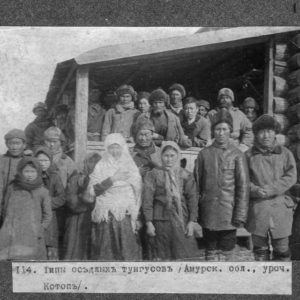
During his expedition, Kulik tried –unsuccessfully- to interview some of the local indigenous Siberian people, known as the Evenki. Reluctant to answer any questions, Kulik offered an Evenk by the name of Ilya Potapovich flour, building materials and cloth, in exchange for leading him to the site of the Tunguska event. Potapovich lead Kulik and his crew on a five-day voyage into the Siberian forest; on March 27th, 1927, the expedition climbed Shakrama Mountain, where Kulik was able to view the charred and flattened trees of the barren, butterfly-winged valley. The Evenki believed that the Tunguska event was a punishment from the thunder god Ogdy and that trespassing upon the area would result in further punishment. Kulik had no choice but to turn around and return to Vanavara and hire new guides.
On April 30th, with help from a new set of guides, Kulik set out again for the fall site, navigating the rivers of the Chamb’e and Khushmo on rafts they’d crafted. The rivers were heavy from the spring melt and the crew had to navigate treacherous river rapids in order to reach their destination.
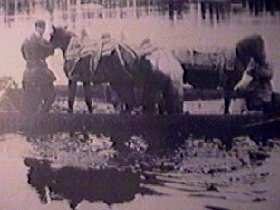
On May 20th, the expedition reached the burnt forest. Kulik finally set up camp near the mouth of the Churgima River. He correctly deduced that the point of impact would be in the opposite direction in which the trees had fallen, and the crater he sought must be just beyond the next ridge in a marshy basin his guides referred to as the Southern Swamp.
Kulik made trips each day through the charred trees until he was satisfied that he had circled the entire area. Surrounding the swamp, flattened trees lay with their tops pointing away from the center. However, instead of finding a crater, Kulik found the centre of the swamp contained nothing but upright, branchless trees. Debranching of such trees requires fast moving shockwaves, powerful enough to strip a tree of its branches before the branches can transfer the impact momentum to the tree’s stem.
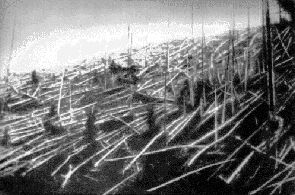
The centre of the swamp consisted of a peat marsh which “heaved outward in giant waves,” according to Kulik. He also noted dozens of flat holes, 10-50 ft in diameter, each one several meters deep. He led two more expeditions back to Siberia, one in 1929 and another in 1938, but was never able to establish with any degree of certainty that the blast was caused by a meteorite.
Kulik continued to investigate the Tunguska event until the Second World War, when he was captured and imprisoned in a German prison camp and died from typhus in April 1942.
In 2013, a team of researchers examined the site of the Tunguska event, discovering micro-particles of meteoric fragments in a peat bog, estimated to have been around in 1908, lending credence to the theory that the Tunguska event was caused by a meteor. The lack of an impact crater is largely explained by the meteor (which was believed to be 60-190metres in diameter) breaking up 5-10km (3-6 miles) above the earth’s surface, causing widespread devastation, but no singular impact point.
Others point to Lake Cheko -which prior 1908 was not recorded on any maps- as the potential source of the (now submerged) impact crater.
Scientists from the University of Bologna claim that the Tunguska event was caused by a meteor exploding in mid-air, but also claim that a 10m fragment struck the ground, leaving an impact crater that would soon become Lake Cheko.
Lake Cheko is bowl shaped, and relatively small, located just 6km (5 miles) from “Ground Zero”. Some have disputed this conclusion, claiming that Lake Cheko contains metres of silt deposits on the lake bed, and could be up to 5000 years old.

More recent research, however, comes to a different conclusion; suggesting that only around a metre of the sediment on Lake Cheko is “normal lacustrine sedimentation”, and that Lake Cheko is around 100 years old. Acoustic-echo tests have been used to map the lake floor, showing that Lake Cheko is not only conical (supporting the theory of an impact crater, but when combined with evidence gather from magnetic readings, it is possible there is a metre-long chunk of rock at the lake’s deepest point. Most prominently, Lake Cheko’s conical shape points directly to the hypocentre of the Tunguska explosion, suggesting that the explosion occurred in mid-air, and a shard of the meteor made an impact crater about 7km away, forming Lake Cheko.
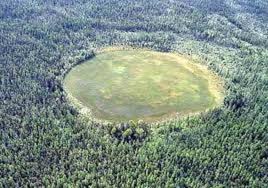
Research is still being conducted to shed more light on the mystery of the Tunguska event; the lessons we can learn from this may help to develop the field of Asteroid impact avoidance, possibly helping to prevent or minimise the damage from celestial bodies that breach our atmosphere and threaten us with mass extinction.






